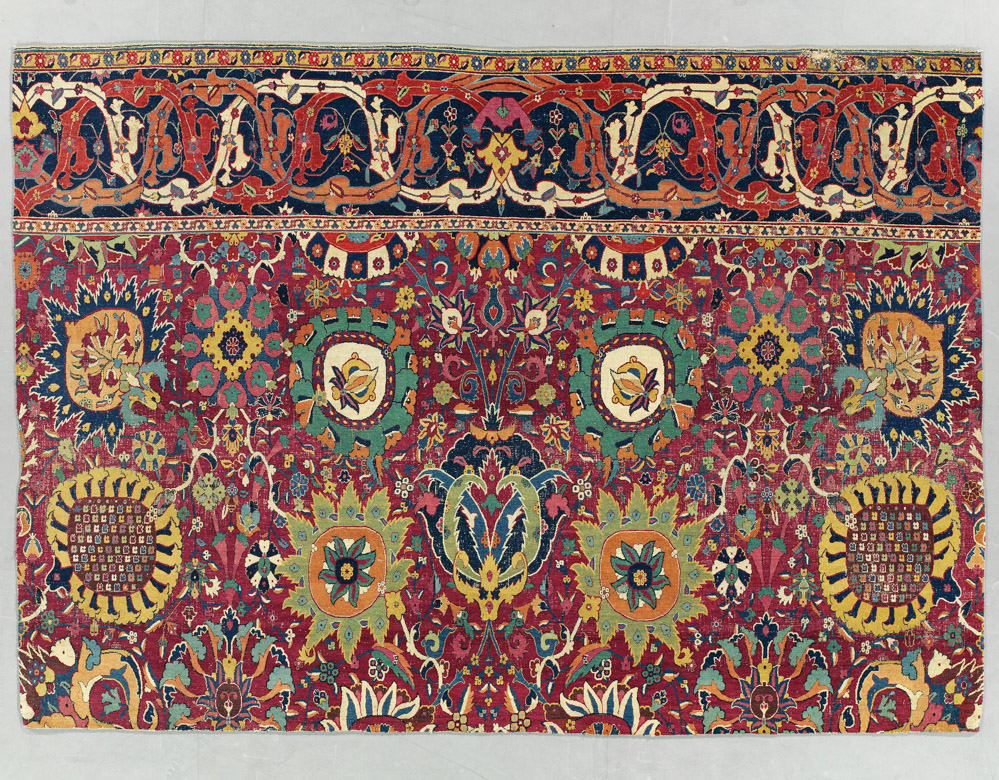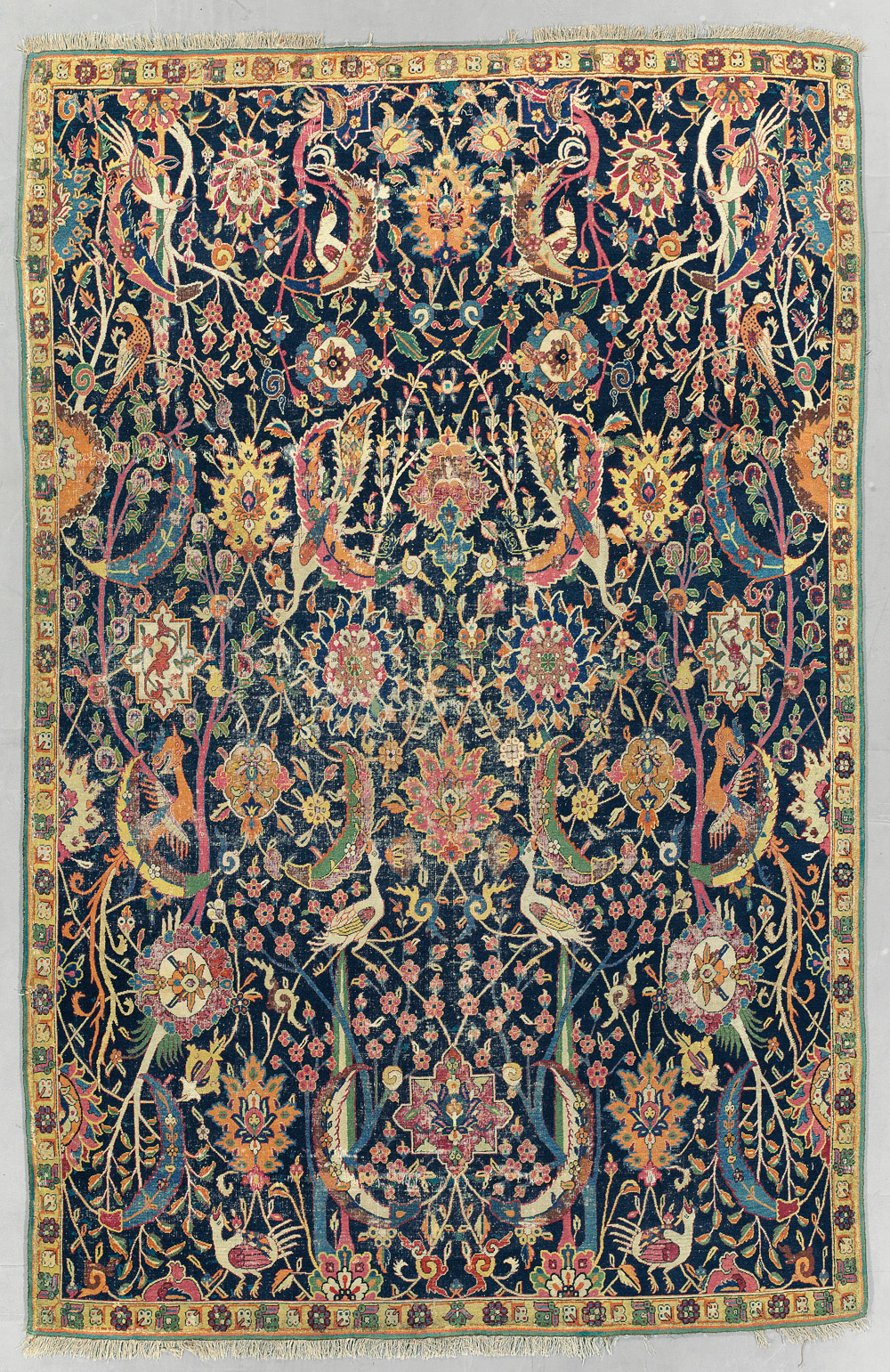Alice de Rothschild’s Vase Carpet Trio at Christie’s
For Christie’s next major London carpet sale at King Street on 19 April 2016, head of department Louise Broadhurst has secured the consignment by ‘A Nobleman’ of three previously unknown and unpublished Safavid ‘vase-technique’ carpets. That alone would be something of a coup for the auctioneers, but the sheer beauty, art historical interest and provenance of the trio add to their lustre.

Kerman ‘vase’ carpet, southeast Persia, late 17th century. 1.51 x 2.51m (5’0” x 8’3”). £1,000,000-1,500,000
The three – a complete small carpet; a large field and top border section of an enormous fragmented carpet; and the entire field and inner guard border of a mid-size carpet – while each very different in design, are in good colour and condition, having been in storage for many years.They all share the same intriguing provenance in the British branch of the Rothschild banking dynasty: first the socialite Alice de Rothschild (d.1922), sometime chatelaine of Waddesdon Manor in Buckinghamshire; then on to her chosen heir, the British philanthropist and politician James (Jimmy) de Rothschild (who bequeathed Waddesdon and its contents to the National Trust on his death in 1957); and thence by descent, probably via his widow Dorothy (Dolly), who died in 1988, to the present noble consignor. The three vase carpets were evidently not part of the Waddesdon Bequest, and were likely to have been kept, if not much seen, in another Rothschild family home in the Vale of Aylesbury, perhaps Alice and later Dolly’s nearby property at Eythrope. Unfortunately, no documentation concerning Alice’s acquisition of the carpets, or their prior provenance, survives.
The first of the trio, complete with just minor damage, is assigned to the late 17th century. Not altogether surprisingly estimated at £1,000,000-1,500,000, it is very close in design and colour to the somewhat larger Behague/Augsburg vase carpet, now in Doha, that sold at King Street in April 2010 for what was then a world record price for an oriental carpet at auction of more than $9.5 million; doubtless a catalyst for the current consignment (HALI 164, p.127). It differs only in size, choice of narrow guard borders, and the fact that part way through the beautifully abrashed mid-blue field of the Rothschild rug, the complex articulation of the lancet-leaf lattice becomes elegantly simplified, with less floral infill.

Kerman ‘vase’ carpet fragment, southeast Persia, early 17th century. 2.86 x 2.05m (9’5” x 6’9”). £250,000-350,000
The second piece, a large, well balanced, field and border section, assigned to the early 17th century and symmetrically cut from the original sometime in the 19th, is particularly finely woven and in wonderful condition. It is estimated at just £250,000-350,000. With huge classic vase carpet palmettes and blossoms on a rich red-ground, topped by a broad blue-ground strap-work border, it represents a significant but previously unrecorded part of a well-known dismembered grand red-ground Kerman carpet (or perhaps a matched pair of carpets?). At least another dozen fragments, large and small, survive in museum collections in Boston, London, Paris, Lyons, Copenhagen, Glasgow, St Petersburg, Berlin and Doha. The fragment now in Doha is the only other piece to appear on the auction market in recent times, when it made just over a quarter of a million dollars at CLO in April 2011 (HALI 168, p.139).
But arguably more wonderful than either of the preceding Rothschild vase carpets is the third, also assigned to the early 17th century and estimated at £400,000-600,000. Although noticeably in the poorest overall surface condition, it is missing everything outside the inner yellow-ground leaf and flower meander guard stripe, and is perhaps not of quite such a regular fine weave as its two companions. However, its beautifully rendered complex multi-plane directional design of paired senmurvs and six other avians, sickle leaves, palmettes, flowering shrubbery, cypresses, cartouches and mini-cloudbands, symmetrical around the central vertical axis on a deep blue ground, appears to have no known direct analogies in the vase carpet canon. On seeing a photograph, a highly regarded writer on Safavid weaving commented, ‘This is an artistic masterpiece, a truly wonderful rug, with stunning colour and an unparalleled richness of design – better than the Corcoran’, referring to the Bacri-Clark red-ground sickle leaf design ‘vase-technique’ Kerman ‘throne’ carpet, sold at Sotheby’s in New York in June 2013 for a record-shattering sum of more than $45 million (HALI 176, p.128), now also believed to be in Doha.

Kerman ‘vase’ carpet fragment, southeast Persia, early 17th century. 1.96 x 3.06m (6’5” x 10’1”). £400,000-600,000
























Comments [0] Sign in to comment